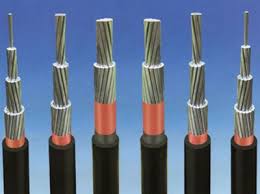Due to the increase of wires and cables, the concentration of laying, the poor quality of construction, etc., the danger of wire and cable fires has increased. Therefore, to prevent aerial bundled cable astm b231 fires in actual engineering applications, it is necessary to start with controlling dangerous factors, apply relevant regulations, and take corresponding fire prevention measures.
1 Fire causes and characteristics of wires and cables
Mainly because of overload, short circuit, excessive contact resistance and external heat source. Causes of fire caused by wires and cables under fault conditions such as short circuit, local overheating and external heat. Insulation materials decrease in insulation resistance, lose insulation ability, or even burn, which may cause a fire. The main characteristics of wires and cables in fire are:
In case of fire, the fire temperature is generally 800℃~1000℃. Wires and cables will quickly lose their insulating ability, which will cause secondary electrical accidents such as short circuits and cause greater losses;
2 The conductor cable has a larger overload capacity under the specified allowable current carrying capacity;
The wire and cable will cause the insulation material to melt and burn in an instant, 3 short-circuit conditions. And ignite the surrounding combustible materials.
2 Analysis of fire performance of aerial bundled cable (abc) astm b231 standard
2.1 Analysis of fire protection mechanism
2.1.1 Flame retardant mechanism
The flame retardant in the condensed phase decomposes and absorbs heat, and is under the heat of the combustion reaction. Slow down the temperature rise in the condensed phase and delay the thermal decomposition rate of the material;
The chain reaction free radical blocker is released, and the flame retardant is decomposed by heat. Interrupt the branches of flame and chain reaction, and slow down the speed of gas phase reaction;
The formation of the coking layer or foam layer strengthens the effect of these layered hard shells in hindering heat transfer; 3 catalyzes the thermal decomposition of the solid phase products of the condensed phase.
The flame retardant has an endothermic phase change, under the action of 4 heat. Physically prevent the temperature rise in the condensed phase.
2.1.2 Fire resistance mechanism
To reduce the heat generated by the polymer, a certain additive is added to the insulation and sheath materials of the wire and cable. Prevent polymer decomposition or promote the carbonization of insulation and sheath materials to form a maintenance layer;
After the insulation and sheath layer is eroded by fire, a layer of mica glass ribbon and other inorganic insulating materials are added to the 2 cores. *The mica refractory tape wrapped around the conductor is maintained and continues to be energized, so as to maintain normal operation for a certain period of time when a fire occurs.
2.1.3 Mechanism of mineral insulated cables
AlOH3 is 34.6% under high temperature operation, and the absorption effect of metal hydrate makes the cable flame-retardant. For example: use AlOH3 and MgOH as flame retardants. MgOHz is 31%, see Reaction Equation 1 and Reaction Equation 2, the reaction is decomposed into an endothermic reaction, which can inhibit the burning of polymers. 2A IOH3–*A lz03+3H20-2648KJ1MgOH2–MgO+H20-93.3KJ2
2.2 Classification of burning characteristics of wires and cables and their standard tests
It can be divided into ordinary wire and cable, flame-retardant wire and cable, fire-resistant wire and cable, halogen-free low-smoke wire and cable, and mineral insulated cable. Wire and cable according to their own burning characteristics.
1 Flame-retardant wires and cables refer to wires and abc cables b230 that are difficult to catch fire and have the ability to prevent or delay the spread of flame. The commonly used standard test is GBT18380. 3 is equivalent to IEC60332-1999
Wire and cable that can still maintain the integrity of the circuit. The commonly used standard test is GBT12666. 6 which is equivalent to IEC60331-21-19992 fire-resistant wire and cable means that it burns under a flame at a specified temperature and time.
When burning, it produces less smoke and has wires and cables that prevent or delay the spread of flames. Commonly used standard tests are GBT17650. 2 is equivalent to IEC60754-2, GBT17651. 2 is equivalent to IEC61034-2 and GBT18380. 3 is equivalent to EC60332-3. On the basis of the above, the flame-retardant and fire-resistant type also need to meet the requirements of maintaining the integrity of the line. 3 There are two types of halogen-free and low-smoke wires and cables. Flame-retardant type means that the material does not contain halogen. At the same time, the commonly used standard test adds GBT12666. 6 is equivalent to IEC60331
